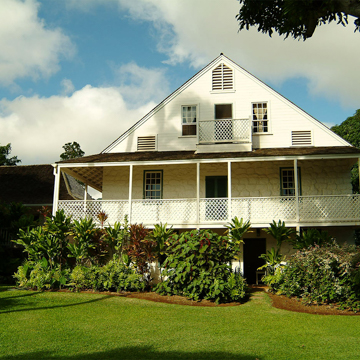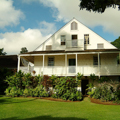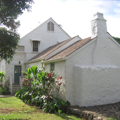Housing the Maui Historical Society since 1957, this three-story, plastered fieldstone dwelling with its steep, New England–influenced gable roof, and small windows, originally sheltered the missionaries assigned to Wailuku. The result of several building episodes, the 30 × 20–foot interior core of the house and the kitchen wing were built by the Reverend Jonathan Green in 1833 and 1837, respectively. The Reverend Edward Bailey connected these two separate structures in 1842, and in 1850 further expanded the house to include the third floor and lanai. The interior spaces remain intact, as does much of the original fabric.
Adjoining the house is a single-story, plastered lava-rock structure with a steep, double-pitched hipped roof. This was the original dining hall for the Wailuku Female Seminary founded in 1837 by Reverend Green in order to remove young Hawaiian ladies from the “contaminating influence of heathen society” and to “make them examples of propriety.” Reverend Bailey assumed leadership of the seminary in 1841 and headed it until it closed in 1849. He then operated a sugar and flour mill, and in 1862 became the first manager of Wailuku Sugar Company.





















